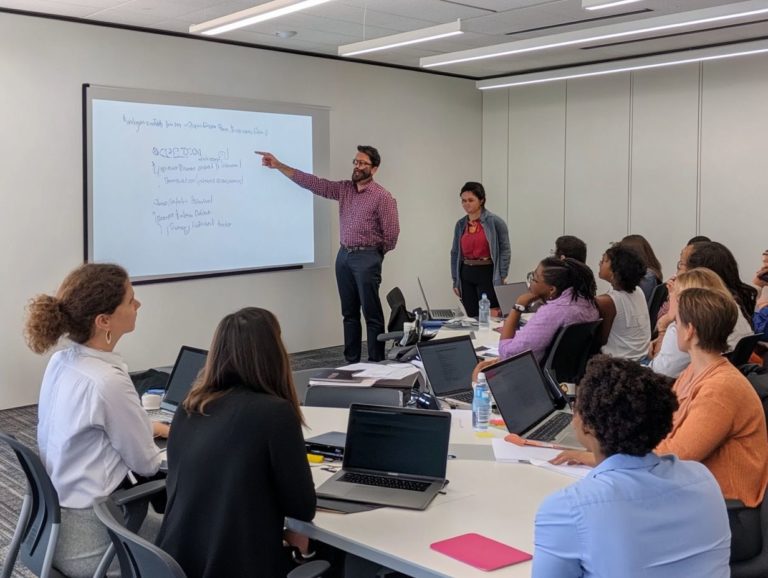How to Address Resistance to Corporate Training?
Corporate training is vital for cultivating growth and innovation within organizations. Yet, it often meets considerable resistance from both management and employees.
Grasping the underlying causes and expressions of this resistance is essential for crafting effective training programs. This article delves into strategies for overcoming resistance, emphasizing the importance of communication, engagement, and fostering a positive learning environment.
It also explores methods for measuring resistance. Ensuring that your training initiatives achieve the desired impact is crucial. Discover how you can turn challenges into opportunities for growth.
Contents
- Key Takeaways:
- Understanding Resistance to Corporate Training
- Effective Strategies for Addressing Resistance
- Dealing with Specific Types of Resistance
- Measuring and Evaluating Resistance
- Frequently Asked Questions
- What are some common reasons for resistance to corporate training?
- How can I address resistance to corporate training?
- What role do managers play in addressing resistance to corporate training?
- How can I make corporate training more engaging and relevant to employees?
- What if an employee still resists corporate training after my efforts to address it?
- How can I measure the effectiveness of my strategies to address resistance to corporate training?
Key Takeaways:

- Resistance to corporate training can stem from various causes and can manifest in different ways. Recognizing these factors is crucial in addressing resistance effectively.
- Effective strategies for addressing resistance include open communication and engagement techniques. Creating a positive learning environment encourages participation and collaboration.
- Resistance can come from different sources, such as management and employees. Understanding the root of resistance and tailoring strategies accordingly can lead to better outcomes.
Understanding Resistance to Corporate Training
It’s crucial for organizations to understand resistance to corporate training for employees. You may notice that resistance can take many shapes, often rooted in fear of change, anxiety about acquiring new skills, or a lack of trust in management s dedication to effective training initiatives.
Industry leaders like Deloitte and IBM emphasize that addressing these underlying dynamics is crucial for success in today s fast-paced workplace. Technology and employee engagement are pivotal in shaping training effectiveness.
By fostering a transparent environment, you can significantly reduce resistance. This encourages collaboration and a collective responsibility for learning.
Causes and Manifestations of Resistance
The causes and manifestations of resistance to corporate training can vary significantly among employees. They are often shaped by their past experiences and the prevailing organizational culture.
Fear of change plays a substantial role, as many individuals may feel unsettled by new methodologies that disrupt their well-established routines. This apprehension often arises from previous negative experiences with training programs that seemed irrelevant or ineffective.
When feedback is lacking during these processes, it can further intensify feelings of disengagement. Employees may become hesitant to engage in initiatives they view as lacking value.
These challenges not only impede individual growth but also dampen overall employee engagement. Ultimately, this jeopardizes the success of training programs and the organization s commitment to fostering a thriving learning environment.
Effective Strategies for Addressing Resistance
To effectively tackle resistance in corporate training, you need to implement strategies that emphasize open communication and actively engage employees. Creating an adaptive learning environment adjusts to the needs of learners.
Consider leveraging technology to streamline your training processes. Ensure that leadership plays an active role in cultivating a positive culture.
By prioritizing transparency and seeking feedback from your team, you will foster trust and reduce the anxieties that often accompany change. This approach will make your training programs more effective and widely accepted.
Don’t let resistance hold you back! Embrace these strategies and watch your training programs transform.
Communication and Engagement Techniques

Effective communication and engagement techniques are essential for you to mitigate resistance to corporate training and create an atmosphere of trust and collaboration.
Implementing regular feedback sessions creates an open dialogue that enables employees to express their concerns and insights. This approach fosters a sense of ownership and accountability among your team members.
For example, companies like Google have leveraged transparent discussions around training goals, ensuring that every team member comprehends the purpose and benefits of their development programs.
Fostering employee involvement through interactive workshops and peer-led training sessions can significantly boost engagement. Prioritizing these techniques leads to better participation rates and creates a culture of continuous learning in your organization.
Creating a Positive Learning Environment
Creating a positive learning environment is crucial for enhancing employee engagement and minimizing resistance to corporate training initiatives. This atmosphere should be rich with supportive elements like open communication, mutual trust, and a culture that values continuous improvement.
When you feel safe to share your thoughts and opinions without fear of judgment, your willingness to participate in learning programs skyrockets.
Organizations can nurture this atmosphere by establishing regular feedback loops opportunities for employees to share their thoughts on training and constructive assessments, promoting peer-to-peer mentorship, and offering ample opportunities for professional development.
For example, companies that celebrate small victories and recognize individual contributions cultivate a profound sense of belonging. This not only motivates you but also inspires active engagement in training and encourages genuine enthusiasm for acquiring new skills.
Dealing with Specific Types of Resistance
Navigating the intricacies of resistance in corporate training demands a tailored approach that addresses the distinct concerns of both management and employees. Understanding common challenges in corporate training can be crucial for success within your organization.
By recognizing and addressing these unique perspectives, you can foster a more effective training environment that encourages collaboration and minimizes pushback.
Resistance from Management
Resistance from management can present significant challenges when you’re trying to implement effective corporate training programs. Often, this resistance stems from concerns about resource allocation and employee performance.
This hesitance typically arises from fears associated with change, including potential disruptions to established workflows and uncertainty surrounding new methodologies.
When there s a lack of transparency regarding the objectives of the training initiatives, skepticism can take root, leading to doubts about the program’s overall value.
To navigate these concerns, it s crucial to foster an environment of open dialogue where management feels enabled to voice their apprehensions.
Integrating leadership support is equally important. By illustrating the long-term benefits and return on investment of training initiatives, you can demonstrate a commitment to enhancing employee capabilities rather than merely shifting existing practices.
Resistance from Employees

Resistance to corporate training often stems from employees’ fears of change, anxiety about mastering new skills, or their belief that their specific training needs aren’t being adequately addressed. To address these concerns, it’s important to explore how to encourage employee participation in training.
These feelings can pose a significant barrier to effective learning and development within your organization. Employees might feel anxious about being evaluated or judged based on their existing competencies, which can amplify their stress.
To overcome these challenges, it’s crucial for management to prioritize open and transparent communication, ensuring that every employee feels heard and valued. By implementing supportive measures, such as feedback sessions and tailored training programs, you can demonstrate a genuine commitment to understanding individual learning styles.
Are you ready to transform training from a duty into a valuable growth opportunity? This approach boosts employee engagement and cultivates a culture of collaboration.
Measuring and Evaluating Resistance
Measuring and evaluating resistance to corporate training is vital for organizations aiming to pinpoint areas for improvement and elevate the overall effectiveness of their training initiatives.
By understanding the nuances of this resistance, you can refine your programs and ensure they resonate more deeply with participants, ultimately driving better outcomes for the organization.
Assessing the Impact of Resistance
Assessing the impact of resistance on corporate training initiatives is essential for grasping its implications on employee engagement and the overall success of training programs.
By meticulously analyzing training results, you can pinpoint specific areas where resistance arises, gaining insight into its effects on employee morale and retention rates.
Employee performance metrics, including productivity levels and outcome assessments, serve as valuable indicators of how resistance influences daily operations.
Utilizing feedback mechanisms whether through surveys or focus groups provides you with a direct line to employees perceptions regarding the effectiveness of training. By gathering and integrating this information, you enable your organization to make informed adjustments to training programs.
This ensures they effectively address resistance and ultimately enhance the overall learning experience.
Tracking Progress and Effectiveness of Strategies
Tracking your progress and evaluating the effectiveness of strategies to reduce resistance in corporate training is essential for ensuring long-term success and fostering employee engagement.
To achieve meaningful outcomes, it s crucial for your organization to implement a robust framework that supports continuous monitoring and actively involves all stakeholders throughout the training journey.
Regular feedback loops create an atmosphere of open communication, making employees feel valued and ensuring their opinions are acknowledged.
Utilizing tools like surveys, performance metrics, and cutting-edge software can help you gather insightful data that can be analyzed to assess the impact of your training methodologies.
Methodologies such as the Kirkpatrick Model, which helps evaluate training effectiveness by measuring reactions, learning, behavioral changes, and results, or 360-degree feedback, which means getting performance feedback from multiple sources, including peers and supervisors, offer comprehensive perspectives on training effectiveness.
These approaches drive continuous improvement and nurture an environment of perpetual learning.
Frequently Asked Questions

What are some common reasons for resistance to corporate training?
Some employees may resist corporate training due to a perceived lack of relevance, time constraints, or negative attitudes towards the training material or trainers.
How can I address resistance to corporate training?
First, it’s important to identify the root cause of the resistance. Then, try to address any concerns or barriers employees may have. Communicate the importance and benefits of the training, and provide support and resources to help employees successfully complete the training.
Your feedback matters! Let us know how we can improve your training experience.
What role do managers play in addressing resistance to corporate training?
Managers are key players in the training process. They should emphasize the importance of training and provide the necessary support and resources to help their teams succeed.
How can I make corporate training more engaging and relevant to employees?
Incorporate interactive elements like group activities and case studies. Tailor the training to fit specific job roles, using real-life examples to enhance relatability.
What if an employee still resists corporate training after my efforts to address it?
Have a one-on-one conversation with the employee to understand their concerns. Collaborate on solutions, and if necessary, involve HR or higher management to tackle resistance effectively.
How can I measure the effectiveness of my strategies to address resistance to corporate training?
Gather feedback from employees and managers to assess the perceived benefits of the training. Track key performance indicators before and after the training to evaluate its overall impact on the organization.





